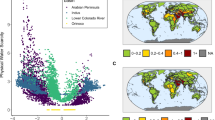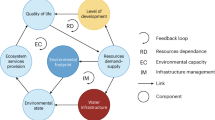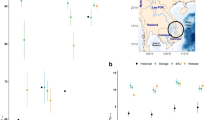Abstract
Human water use, climate change and land conversion have created a water crisis for billions of individuals and many ecosystems worldwide. Global water stocks and fluxes are estimated empirically and with computer models, but this information is conveyed to policymakers and researchers through water cycle diagrams. Here we compiled a synthesis of the global water cycle, which we compared with 464 water cycle diagrams from around the world. Although human freshwater appropriation now equals half of global river discharge, only 15% of the water cycle diagrams depicted human interaction with water. Only 2% of the diagrams showed climate change or water pollution—two of the central causes of the global water crisis—which effectively conveys a false sense of water security. A single catchment was depicted in 95% of the diagrams, which precludes the representation of teleconnections such as ocean–land interactions and continental moisture recycling. These inaccuracies correspond with specific dimensions of water mismanagement, which suggest that flaws in water diagrams reflect and reinforce the misunderstanding of global hydrology by policymakers, researchers and the public. Correct depictions of the water cycle will not solve the global water crisis, but reconceiving this symbol is an important step towards equitable water governance, sustainable development and planetary thinking in the Anthropocene.
This is a preview of subscription content, access via your institution
Access options
Access Nature and 54 other Nature Portfolio journals
Get Nature+, our best-value online-access subscription
$29.99 / 30 days
cancel any time
Subscribe to this journal
Receive 12 print issues and online access
$259.00 per year
only $21.58 per issue
Buy this article
- Purchase on Springer Link
- Instant access to full article PDF
Prices may be subject to local taxes which are calculated during checkout




Similar content being viewed by others
Data availability
The meta-analysis of global water pools and fluxes is included in Supplementary Table 1. The extracted data from all the diagrams is available in the Supplementary Database 1. The full set of analysed images cannot be published here because of copyright considerations, but all images are available from the corresponding author upon request.
References
Cardak, O. Science students’ misconceptions of the water cycle according to their drawings. J. Appl. Sci. 9, 865–873 (2009).
Ben-zvi-Assarf, O. & Orion, N. A study of junior high students’ perceptions of the water cycle. J. Geosci. Educ. 53, 366–373 (2005).
Ellison, D., N. Futter, M. & Bishop, K. On the forest cover–water yield debate: from demand- to supply-side thinking. Glob. Change Biol. 18, 806–820 (2012).
Schmidt, J. J. Historicizing the hydrosocial cycle. Water Altern. 7, 220–234 (2014).
Fandel, C. A., Breshears, D. D. & McMahon, E. E. Implicit assumptions of conceptual diagrams in environmental science and best practices for their illustration. Ecosphere 9, e02072 (2018).
Linton, J. Is the hydrologic cycle sustainable? A historical–geographical critique of a modern concept. Ann. Assoc. Am. Geogr. 98, 630–649 (2008).
Clark, A. C. & Wiebe, E. N. Scientific visualization for secondary and post-secondary schools. J. Technol. Stud. 26, 24–32 (2000).
Harold, J., Lorenzoni, I., Shipley, T. F. & Coventry, K. R. Cognitive and psychological science insights to improve climate change data visualization. Nat. Clim. Change 6, 1080–1089 (2016).
Richey, A. S. et al. Uncertainty in global groundwater storage estimates in a total groundwater stress framework. Water Resour. Res. 51, 5198–5216 (2015).
Rockström, J., Falkenmark, M., Lannerstad, M. & Karlberg, L. The planetary water drama: dual task of feeding humanity and curbing climate change. Geophys. Res. Lett. 39, L15401 (2012).
Hoekstra, A. Y. & Mekonnen, M. M. The water footprint of humanity. Proc. Natl Acad. Sci. USA 109, 3232–3237 (2012).
Mekonnen, M. M. & Hoekstra, A. Y. Four billion people facing severe water scarcity. Sci. Adv. 2, e1500323 (2016).
Vörösmarty, C. J. et al. Global threats to human water security and river biodiversity. Nature 467, 555–561 (2010).
Heathwaite, A. L. Multiple stressors on water availability at global to catchment scales: understanding human impact on nutrient cycles to protect water quality and water availability in the long term. Freshw. Biol. 55, 241–257 (2010).
Schyns, J. F., Hoekstra, A. Y., Booij, M. J., Hogeboom, R. J. & Mekonnen, M. M. Limits to the world’s green water resources for food, feed, fiber, timber and bioenergy. Proc. Natl Acad. Sci. USA 116, 4893–4898 (2019).
Ellis, E. C., Klein Goldewijk, K., Siebert, S., Lightman, D. & Ramankutty, N. Anthropogenic transformation of the biomes, 1700 to 2000. Glob. Ecol. Biogeogr. 19, 586–606 (2010).
Wang-Erlandsson, L. et al. Remote land use impacts on river flows through atmospheric teleconnections. Hydrol. Earth Syst. Sci. 22, 4311–4328 (2018).
Falkenmark, M., Wang-Erlandsson, L. & Rockström, J. Understanding of water resilience in the Anthropocene. J. Hydrol. X 2, 100009 (2019).
Boers, N., Marwan, N., Barbosa, H. M. J. & Kurths, J. A deforestation-induced tipping point for the South American monsoon system. Sci. Rep. 7, 41489 (2017).
Durack, P. J., Wijffels, S. E. & Matear, R. J. Ocean salinities reveal strong global water cycle intensification during 1950 to 2000. Science 336, 455–458 (2012).
Haddeland, I. et al. Global water resources affected by human interventions and climate change. Proc. Natl Acad. Sci. USA 111, 3251–3256 (2014).
Huang, J., Yu, H., Guan, X., Wang, G. & Guo, R. Accelerated dryland expansion under climate change. Nat. Clim. Change 6, 166–171 (2016).
Fan, Y., Li, H. & Miguez-Macho, G. Global patterns of groundwater table depth. Science 339, 940–943 (2013).
Van Loon, A. F. et al. Drought in the Anthropocene. Nat. Geosci. 9, 89–91 (2016).
Famiglietti, J. S. The global groundwater crisis. Nat. Clim. Change 4, 945–948 (2014).
Creed, I. F. et al. Enhancing protection for vulnerable waters. Nat. Geosci. 10, 809–815 (2017).
Wurtsbaugh, W. A. et al. Decline of the world’s saline lakes. Nat. Geosci. 10, 816–821 (2017).
Ellison, D. et al. Trees, forests and water: cool insights for a hot world. Glob. Environ. Change 43, 51–61 (2017).
Falkenmark, M. Society’s interaction with the water cycle: a conceptual framework for a more holistic approach. Hydrol. Sci. J. 42, 451–466 (1997).
Oki, T. & Kanae, S. Global hydrological cycles and world water resources. Science 313, 1068–1072 (2006).
Linton, J. Modern water and its discontents: a history of hydrosocial renewal. WIREs Water 1, 111–120 (2014).
Savenije, H. H. G., Hoekstra, A. Y. & van der Zaag, P. Evolving water science in the Anthropocene. Hydrol. Earth Syst. Sci. 18, 319–332 (2014).
Gleeson, T., Befus, K. M., Jasechko, S., Luijendijk, E. & Cardenas, M. B. The global volume and distribution of modern groundwater. Nat. Geosci. 9, 161–167 (2016).
Bierkens, M. F. P. Global hydrology 2015: state, trends, and directions. Water Resour. Res. 51, 4923–4947 (2015).
Trenberth, K. E., Smith, L., Qian, T., Dai, A. & Fasullo, J. Estimates of the global water budget and its annual cycle using observational and model data. J. Hydrometeorol. 8, 758–769 (2007).
Chao, B. F., Wu, Y. H. & Li, Y. S. Impact of artificial reservoir water impoundment on global sea level. Science 320, 212–214 (2008).
Döll, P. Vulnerability to the impact of climate change on renewable groundwater resources: a global-scale assessment. Environ. Res. Lett. 4, 035006 (2009).
Jasechko, S. et al. Global aquifers dominated by fossil groundwaters but wells vulnerable to modern contamination. Nat. Geosci. 10, 425–429 (2017).
Wang, J. et al. Recent global decline in endorheic basin water storages. Nat. Geosci. 11, 926–932 (2018).
Messager, M. L., Lehner, B., Grill, G., Nedeva, I. & Schmitt, O. Estimating the volume and age of water stored in global lakes using a geo-statistical approach. Nat. Commun. 7, 13603 (2016).
Alley, W. M. Another water budget myth: the significance of recoverable ground water in storage. Ground Water 45, 251–251 (2007).
Hanasaki, N., Inuzuka, T., Kanae, S. & Oki, T. An estimation of global virtual water flow and sources of water withdrawal for major crops and livestock products using a global hydrological model. J. Hydrol. 384, 232–244 (2010).
Hogeboom, R. J., Knook, L. & Hoekstra, A. Y. The blue water footprint of the world’s artificial reservoirs for hydroelectricity, irrigation, residential and industrial water supply, flood protection, fishing and recreation. Adv. Water Resour. 113, 285–294 (2018).
Radinsky, J. et al. How planners and stakeholders learn with visualization tools: using learning sciences methods to examine planning processes. J. Environ. Plan. Manag. 60, 1296–1323 (2017).
Wiek, A. & Larson, K. L. Water, people, and sustainability—a systems framework for analyzing and assessing water governance regimes. Water Resour. Manag. 26, 3153–3171 (2012).
Horton, R. E. The field, scope, and status of the science of hydrology. Eos Trans. AGU 12, 189–202 (1931).
Hagerhall, C. M., Purcell, T. & Taylor, R. Fractal dimension of landscape silhouette outlines as a predictor of landscape preference. J. Environ. Psychol. 24, 247–255 (2004).
Bishop, K. et al. Nature as the ‘natural’ goal for water management: a conversation. Ambio 38, 209–214 (2009).
Linton, J. & Budds, J. The hydrosocial cycle: defining and mobilizing a relational-dialectical approach to water. Geoforum 57, 170–180 (2014).
Bennett, B. M. & Barton, G. A. The enduring link between forest cover and rainfall: a historical perspective on science and policy discussions. For. Ecosyst. 5, 5 (2018).
Keys, P. W., Wang-Erlandsson, L., Gordon, L. J., Galaz, V. & Ebbesson, J. Approaching moisture recycling governance. Glob. Environ. Change 45, 15–23 (2017).
Dieter, C. A. et al. Estimated Use of Water in the United States in 2015 (US Geological Survey, 2018).
French, J. R. et al. Precipitation formation from orographic cloud seeding. Proc. Natl Acad. Sci. USA 115, 1168–1173 (2018).
Gordon, L. J. et al. Human modification of global water vapor flows from the land surface. Proc. Natl Acad. Sci. USA 102, 7612–7617 (2005).
Kundzewicz, Z. W. & Kaczmarek, Z. Coping with hydrological extremes. Water Int. 25, 66–75 (2000).
Grey, D. & Sadoff, C. W. Sink or swim? Water security for growth and development. Water Policy 9, 545–571 (2007).
Wilby, R. L. et al. Evidence needed to manage freshwater ecosystems in a changing climate: turning adaptation principles into practice. Sci. Total Environ. 408, 4150–4164 (2010).
Prudhomme, C. et al. Hydrological droughts in the 21st century, hotspots and uncertainties from a global multimodel ensemble experiment. Proc. Natl Acad. Sci. USA 111, 3262–3267 (2014).
Rodell, M. et al. The observed state of the water cycle in the early twenty-first century. J. Clim. 28, 8289–8318 (2015).
Kümmerer, K., Dionysiou, D. D., Olsson, O. & Fatta-Kassinos, D. A path to clean water. Science 361, 222–224 (2018).
Abbott, B. W. et al. Unexpected spatial stability of water chemistry in headwater stream networks. Ecol. Lett. 21, 296–308 (2018).
Bormann, F. H. & Likens, G. E. Nutrient Cycling. Science 155, 424–429 (1967).
Müller, B. et al. How polluted is the Yangtze river? Water quality downstream from the Three Gorges Dam. Sci. Total Environ. 402, 232–247 (2008).
Moatar, F., Abbott, B. W., Minaudo, C., Curie, F. & Pinay, G. Elemental properties, hydrology, and biology interact to shape concentration–discharge curves for carbon, nutrients, sediment, and major ions. Water Resour. Res. 53, 1270–1287 (2017).
Salama, R. B., Otto, C. J. & Fitzpatrick, R. W. Contributions of groundwater conditions to soil and water salinization. Hydrogeol. J. 7, 46–64 (1999).
CreedI. F.. & van NoordwijkM.. Forest and Water on a Changing Planet: Vulnerability. Adaptation and Governance Opportunities (2018).
Kastens, K. A. & Manduca, C. A. Earth and Mind II: A Synthesis of Research on Thinking and Learning in the Geosciences (Geological Society of America, 2012).
Vekiri, I. What is the value of graphical displays in learning? Educ. Psychol. Rev. 14, 261–312 (2002).
Gunckel, K. L., Covitt, B. A., Salinas, I. & Anderson, C. W. A learning progression for water in socio-ecological systems. J. Res. Sci. Teach. 49, 843–868 (2012).
Rumore, D., Schenk, T. & Susskind, L. Role-play simulations for climate change adaptation education and engagement. Nat. Clim. Change 6, 745–750 (2016).
Su, C.-H. & Cheng, C.-H. A mobile gamification learning system for improving the learning motivation and achievements. J. Comput. Assist. Learn. 31, 268–286 (2015).
Vörösmarty, C. et al. Humans transforming the global water system. Eos Trans. AGU 85, 509–514 (2004).
Falkenmark, M. Heading towards basin-level hydrosolidarity goal for land/water/ecosystem coordination. Water Environ. 12, 178 (2005).
Wickham, H. ggplot2: Elegant Graphics for Data Analysis: (Springer, 2009).
Jasechko, S., Kirchner, J. W., Welker, J. M. & McDonnell, J. J. Substantial proportion of global streamflow less than three months old. Nat. Geosci. 9, 126–129 (2016).
Lvovitch, M. I. The global water balance. Eos Trans. AGU 54, 28–53 (1973).
Gombrich, E. H. Moment and movement in art. J. Warbg. Court. Inst. 27, 293–306 (1964).
Acknowledgements
Financial support for this study was provided by the Department of Plant and Wildlife Sciences and College of Life Sciences at Brigham Young University and by the European Union’s Seventh Framework Program for research, technological development and demonstration under grant agreement no. 607150 (FP7-PEOPLE-2013-ITN–INTERFACES—Ecohydrological interfaces as critical hotspots for transformations of ecosystem exchange fluxes and biogeochemical cycling). D. Conner created the template for the water cycle used in Figs. 3 and 4. We thank T. Burt, S. Abbott, J. Howe and C. Ash for input on the manuscript and we thank S. Chowdhury for assistance with diagram analysis.
Author information
Authors and Affiliations
Contributions
The concept for this paper emerged during discussion among B.W.A., K.B., G.P., T.K., D.M.H., S.K. and J.P.Z. in 2015. S.P., S.E.G., T.K., J.M., O.U., M.C., R.J.F., B.W.A. and M.B. downloaded and analysed the diagrams. B.W.A. and C.M. managed data and performed statistical analyses. B.W.A. wrote the manuscript with input from all the co-authors.
Corresponding author
Ethics declarations
Competing interests
The authors declare no competing interests.
Additional information
Publisher’s note: Springer Nature remains neutral with regard to jurisdictional claims in published maps and institutional affiliations.
Supplementary information
Supplementary Information
Supplementary Tables and Figures
Water Diagram Database
Water Diagram Database
New diagrams
New diagrams (PDF and PPT)
Rights and permissions
About this article
Cite this article
Abbott, B.W., Bishop, K., Zarnetske, J.P. et al. Human domination of the global water cycle absent from depictions and perceptions. Nat. Geosci. 12, 533–540 (2019). https://doi.org/10.1038/s41561-019-0374-y
Received:
Accepted:
Published:
Issue Date:
DOI: https://doi.org/10.1038/s41561-019-0374-y
This article is cited by
-
Global peak water limit of future groundwater withdrawals
Nature Sustainability (2024)
-
Human-induced intensification of terrestrial water cycle in dry regions of the globe
npj Climate and Atmospheric Science (2024)
-
Defining the term watershed to reflect modern uses and functions as inter- and intra-connected socio-hydrologic systems
Journal of Environmental Studies and Sciences (2024)
-
Prioritizing water availability study settings to address geogenic contaminants and related societal factors
Environmental Monitoring and Assessment (2024)
-
Study on the safety of recycled water irrigation in arid, semiarid and underdeveloped areas: a case study in Qinghai Province
Irrigation Science (2024)



